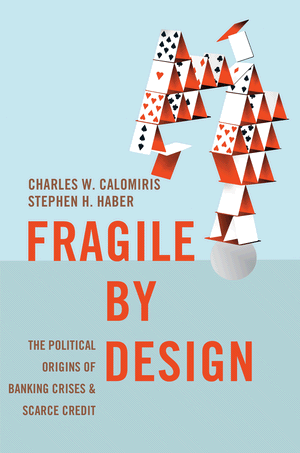What’s important about the gold standard is the discipline it provides to support price stability.
The Marriage of Governments and Banks—For Better or for Worse
Charles Calomiris and Stephen Haber, combining their scholarly command of banking and political institutions, have published a book full of fertile ideas, instructive histories of the evolution of a number of banking systems, and provocative interpretations of the co-dependency between banks and governments.
Fragile by Design: The Political Origins of Banking Crises and Scarce Credit presents three fundamental propositions:
· Each nation’s banking system needs to be understood as a mutually profitable deal between the politicians who control the government and the bankers who get government charters for their banks.
· These deals vary among countries in historically contingent or “path-dependent” ways, resulting in quite different banking systems—in some countries, robust; in others, systems prone to collapse.
· The governments of modern states absolutely need banks, not least to lend money to the government itself. In exchange, the banks are granted various charter privileges, including restricted competition and government support. Likewise, the banks need the government for their chartered existence. The working out of the specifics of these deals is what the authors call, “the game of bank bargains.”
Thinking of banking systems in this fashion, as deals between governments and banks, is without question a deep and powerful perspective.
 As a perfect current example, consider that European banks are now excessively exposed to the credit of European “sovereign borrowers,” i.e. governments. In two particular cases, as economist Brendan Brown observed in a recent newsletter, “Spanish and Italian banks have been loading up on their domestic government bonds, as part of their deal in the overall rescuing of those respective sovereigns from insolvency.” [1]
As a perfect current example, consider that European banks are now excessively exposed to the credit of European “sovereign borrowers,” i.e. governments. In two particular cases, as economist Brendan Brown observed in a recent newsletter, “Spanish and Italian banks have been loading up on their domestic government bonds, as part of their deal in the overall rescuing of those respective sovereigns from insolvency.” [1]
Meanwhile, paradoxically enough, the credit of the banks themselves is dependent on the support of these governments.
Brown continues: “Yes, the banks get regulatory forbearance on their holding of government bonds”—of course, since the regulators work for the government!—“and can treat the carry trade profit on these as full earnings with no loss reserves. And yes, there are barriers to entry of new banks who would not own legacy bad assets and who might refuse to take part in government financing. Yet would-be equity shareholders are deeply anxious about this façade.”
In one sense it is indeed a façade. But in another, it is a classic government-bank bargain. The European situation has been referred to as “the perverse nexus” of governments and banks. Calomiris and Haber’s argument is that a nexus between these two is always there, though it may or may not be perverse.
In this perspective, “banks” include the central banks, which are an essential part of the banking system and an essential part of the government-bank deal. We see this in the European Central Bank’s “whatever it takes” support of government debts, and even more clearly in the Federal Reserve’s monetization of U.S. Treasury debt and government mortgage securities—to the combined tune of $4 trillion.
This pattern is nothing new. A central bank is always available to lend money to its government when needed, having gotten monopoly powers in exchange. The archetype here is the creation of the Bank of England. As discussed in Fragile by Design, the foundation of that institution in 1694 was a bank-government deal in pure form: The bank committed to lend the government money to finance King William’s wars against France, in return gaining a monopoly on limited-liability banking and on currency-issuance in London.
In other words, the long-term history of banking cannot be considered apart from the history of wars. They generate the biggest governmental need for borrowing and for inflationary depreciation of debts.
Calomiris and Haber consider the U.S. Civil War for a notable example of such a bank bargain. The U.S. National Banking Act of 1863-64 (originally called the National Currency Act) was designed as a key piece of war finance by the Lincoln administration. To help finance the Union’s vast military effort, it created national banks that could issue paper currency for a profit, but that had to buy an equivalent amount of U.S. government bonds to do so—a clever idea. The law was also intended to create a uniform national currency and to drive out of circulation the currency previously issued by hundreds of state-chartered banks.
It was thus a nationalist idea, and yet, as the authors convincingly describe, it left intact an older bank deal, which guaranteed a state-centered banking system of mostly small, undiversified, local unit banks. The continuation of that arrangement was, they argue, the result of a robust political coalition between rural populists and small bankers to fend off any concentration of financial power in the form of nationwide banks. The success of this coalition for 150 years meant that U.S. banks were limited to single states, and often to single offices—as they were when I was a young banking officer.
The result of this long-standing government-bank deal, the authors argue, was to give the United States a fragmented, risky banking system prone to periodic panics and collapses. Banking crises, by the authors’ count, occurred in: 1837, 1839, 1857, 1861, 1873, 1884, 1890, 1893, 1896, 1907, the 1920s, 1930-33, 1980-92, and 2007-09. (The crisis of 1974-76 needs to be added.)
In time, Calomiris and Haber relate, the coalition of rural populists and small banks got replaced by a new one: urban populists and big banks. This reflected the shift from a predominantly rural to a predominantly urban population, but also a new political dynamic brought by the ongoing banking consolidation of the last three decades. Federal legislation of the 1970s put urban populist “community groups” in a position to object to, delay, or possibly stop mergers planned by the big banks, as the long-delayed natural consolidation of American banking got rolling. It was cheaper and more efficient for the big banks to give money and loans of lower credit quality to the constituencies of the urban populist organizations, than to have their mergers held up or scuttled. This gave rise to the new political alliance.
The tectonic shift of the American bank bargain over time is strikingly symbolized by the names of the congressional committees that have jurisdiction over banks. Traditionally, in both the U.S. Senate and House of Representatives, the name was the “Committee on Banking and Currency.” A sensible title. But in the 1970s, the Senate committee changed to “The Committee on Banking, Housing and Urban Affairs” while the House changed to “The Committee on Banking, Finance and Urban Affairs.” These convey very different ideas from before. As a former Senate committee staffer told me, “It seemed like the committee was more about housing than banking.”
After the Republicans took control of the House of Representatives in the 1990s, they changed the House committee’s name yet again, to “The Committee on Financial Services.” The names now suggest distinct approaches on the part of these committees: one wanting to push the government as the guarantor of mortgages and the promoter of low-quality mortgage loans and higher leverage, the other not.
A banking system with a different bank bargain, and the banking system most admired by Calomiris and Haber, is that of Canada. Indeed the Canadian system has much to say for it, especially its long-term stability as contrasted with the U.S. propensity for cyclical collapses.
The historical development of the Canadian banking system is laid out in interesting detail.
Since 1839, the authors write:
some Canadian banks have failed, but the country has experienced no systemic banking crises. The Canadian system has been extraordinarily stable . . . there has been little need for government intervention in support of the banks since Canada became an independent country in 1867.
Canada’s notable banking stability convincingly refutes the theory of the proponents of the Glass-Steagall Act, or more recently, of the “Volcker Rule.” The principal Canadian banks are all universal banks combining commercial, investment, and retail banking, as well as other financial services—just what the devotees of these theories claim leads to instability and crisis.
Canada is similar to the United States in many ways, though economically smaller, with about 11 percent of the population and 11 percent of the GDP. But its banking assets are proportionately much bigger, about 23 percent of U.S. banking assets. Its banking structure is completely different: in contrast to the 7,000 U.S. banks, only five nationwide banks entirely dominate Canadian banking.
An oligopoly of five nationwide banks has evidently provided impressive stability. But this leads to a key question: Is Canadian banking competitive, with the advantages for customers only competition can bring? Calomiris and Haber consider the evidence and conclude that it is quite competitive.
So what’s not to like?
Maybe real-estate lending? Interestingly, U.S. national banks and Canadian chartered banks were both originally prohibited from making real-estate loans, since these were considered too risky for banks. In both countries, that prohibition is long gone. In the U.S., even the central bank is now a $1.7 trillion investor in mortgage securities, and the five big Canadian banks own most of the real-estate mortgages there.
Canada did not share in the extremes of the 2007-09 banking crisis, but now seems to have its own housing bubble. At least house prices there are at historic highs, having increased far more than U.S. house prices did at the peak of their bubble. What happens to the Canadian banking system if or when its housing bubble deflates? Will it retain its historical record of banking stability?
This may be a good stress test for the Canadian bank bargain.
Thinking of the future, I wish the authors had added to their enlightening history more explicit prescriptions for improving America’s government-bank deal. For example, they might have taken up these questions:
Would Americans want five nationwide, universal banks with 90 percent of the market among them, in exchange for the stability of the Canadian system?
If five is too few oligopolistic, nationwide banks for a country as big as the United States, how many such banks should there be? 10? 20? More?
Should we try to move to a non-populist bank bargain like Canada’s? Even though the theory of Fragile by Design suggests that given our historical path, we can’t get there, should we try?
How many banks—small and large—should the United States have in total, if the current 7,000 makes the American system too fragmented and too unstable? Three thousand? A thousand? Five hundred? Fewer?
How in the world can we undo the housing part of the U.S. bank bargain and defeat the coalition that promotes hyper-leveraged real-estate risk? Is some other winning coalition possible?
Perhaps a sequel to this provocative book will address these questions.
1 Brendan Brown, “The Rising Economic Toll of Delayed Debt Insolvency in Spain and Italy,” Economic Viewpoint, March 12, 2014
